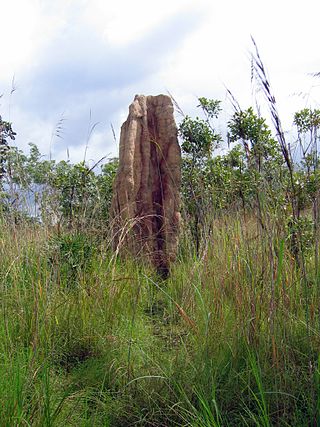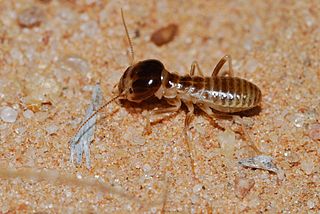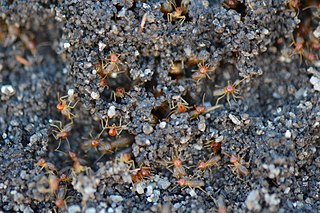
Termites are a group of detritophagous eusocial insects which consume a wide variety of decaying plant material, generally in the form of wood, leaf litter, and soil humus. They are distinguished by their moniliform antennae and the soft-bodied and typically unpigmented worker caste for which they have been commonly termed "white ants"; however, they are not ants, to which they are distantly related. About 2,972 extant species are currently described, 2,105 of which are members of the family Termitidae.

A nest is a structure built for certain animals to hold eggs or young. Although nests are most closely associated with birds, members of all classes of vertebrates and some invertebrates construct nests. They may be composed of organic material such as twigs, grass, and leaves, or may be a simple depression in the ground, or a hole in a rock, tree, or building. Human-made materials, such as string, plastic, cloth, or paper, may also be used. Nests can be found in all types of habitat.

The Numbat, scientifically known as Myrmecobius fasciatus, belongs to the genus Myrmecobius, which is the sole member of the family Myrmecobiidae. This unique family is one of four that make up the order Dasyuromorphia, a group of Australian marsupial carnivores.

Mound-building termites are a group of termite species that live in mounds which are made of a combination of soil, termite saliva and dung. These termites live in Africa, Australia and South America. The mounds sometimes have a diameter of 30 metres (98 ft). Most of the mounds are in well-drained areas. Termite mounds usually outlive the colonies themselves. If the inner tunnels of the nest are exposed it is usually dead. Sometimes other colonies, of the same or different species, occupy a mound after the original builders' deaths.

The smooth-fronted caiman, also known as Schneider's dwarf caiman or Schneider's smooth-fronted caiman, is a crocodilian from South America, where it is native to the Amazon and Orinoco Basins. It is the second-smallest species of the family Alligatoridae, the smallest being Cuvier's dwarf caiman, also from tropical South America and in the same genus. An adult typically grows to around 1.2 to 1.6 m in length and weighs between 9 and 20 kg. Exceptionally large males can reach as much as 2.3 m (7.5 ft) in length and 36 kg (79 lb) in weight.

The Macrotermitinae, the fungus-growing termites, constitute a subfamily of the family Termitidae that is only found within the Old World tropics.

Trinervitermes trinervoides is a species of termite belonging to family Termitidae. It is native to and widespread in southern Africa where it inhabits mesic to semi-arid grasslands. Due to the snout on the head of soldiers, and their grass collecting habits, they are known as snouted harvester termites.

The Hodotermitidae are a basal Old World family of termites known as the harvester termites. They are distinguished by the serrated inner edge of their mandibles, and their functional compound eyes which are present in all castes. They forage for grass at night and during daylight hours, and the pigmented workers are often observed outside the nest. Their range includes the deserts and savannas of Africa, the Middle East, and Southwest Asia. Their English name refers to their habit of collecting grass, which is not unique to the family however.

Hodotermes is a genus of African harvester termites in the Hodotermitidae. They range from Palaearctic North Africa, through the East African savannas to the karroid regions of southern Africa. As with harvester termites in general, they have serrated inner edges to their mandibles, and all castes have functional compound eyes. They forage for grass at night and during the day, and their pigmented workers are often observed outside the nest.

Termitotrox cupido is a species of scarab beetle in the subfamily Termitotroginae. It was first described by Munetoshi Maruyama in 2012, having been discovered living inside a nest of the termite Hypotermes makhamensis in Cambodia. It is a tiny, blind and flightless insect.
Hypotermes makhamensis is a species of termite in the subfamily Macrotermitinae of the family Termitidae. It lives in dry evergreen forests in tropical south-eastern Asia and builds termite mounds in which it cultivates fungus for use as food.
Coptotermes frenchi, the Australian subterranean termite, is a species of termite in the family Rhinotermitidae. Termites are social insects and C. frenchi usually builds its communal nest in the root crown of a tree. From this, a network of galleries extends through the nearby soil, enabling the workers to forage in the surrounding area without emerging on the surface of the ground.

Coptotermes lacteus, the milk termite, is a species of termite in the family Rhinotermitidae, native to Australia. These termites are social insects and build a communal nest in the form of a mound. From this, a network of galleries extends through the nearby soil, enabling the workers to forage in the surrounding area without emerging on the surface of the ground.

Coptotermes acinaciformis is a species of subterranean termite in the family Rhinotermitidae native to Australia. Termites are social insects and build a communal nest. In the case of C. acinaciformis, this is either in the root crown of a tree or underground. From this, a network of galleries extends through the nearby soil, enabling the workers to forage in the surrounding area without emerging on the surface of the ground. This termite can cause substantial damage to trees and the wooden parts of buildings.

Macrotermes michaelseni is a species of termite in the family Termitidae, found in sub-Saharan Africa. It is associated with the fungus Termitomyces schimperi.

Nasutitermes triodiae, also known as the cathedral termite, is a grass-eating species of Nasutitermitinae termite that can be found in Northern Territory, Australia. It is also sometimes referred to as the spinifex termite, since it is found in the spinifex grasslands. Very little research has been done on the underground nature of this species.

Macrotermes is a genus of termites belonging to the subfamily Macrotermitinae and widely distributed throughout Africa and South-East Asia. Well-studied species include Macrotermes natalensis and M. bellicosus.

Amitermes hastatus, commonly known as the black mound termite, is a species of termite found in the Western Cape region of South Africa. It is endemic to the region's fynbos ecosystem. They build distinctive black termite mounds that range in height from a few centimeters to 50 centimeters. The species is commonly found on sandy soil eroded from white Table Mountain sandstone at altitudes from just under 100 meters up to 900 meters above sea level.

Odontotermes is a termite genus belonging to subfamily Macrotermitinae, which is native to the Old World. They are most destructive in wooden homes, and are agricultural pests in the tropics and subtropics of Africa and Asia. It is the most diverse termite genus in Africa, with 78 species recorded.
Amitermes floridensis, commonly known as the Florida darkwinged subterranean termite, is a species of eusocial insect in the family Termitidae. It feeds on rotting wood, reached by a network of tunnels. It is endemic to west central Florida and was first described in 1989.
















